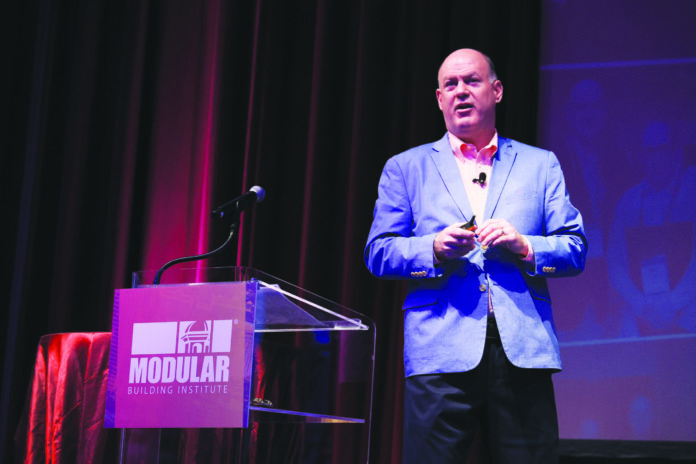A conversation with Tom Hardiman of the Modular Home Building Association.
Tom Hardiman has more than 20 years of experience in systems building. He currently serves as Executive Director of both the Modular Home Building Association (MHBA) and the Modular Building Institute (MBI). We recently caught up with Tom to get his thoughts on the modular industry, including what challenges lie ahead for both builders and developers.

OB: How would you describe growth in the modular industry?
TH: We’re trending in the right direction with commercial modular, mostly in multifamily. Just five years ago, the multifamily market was a project here, a project there, but it has since grown to 24% of factory output. It’s now the largest sector for the commercial side of the business.
OB: What have been some ramifications of COVID?
TH: It didn’t slow our industry down much. Factories were deemed essential, so they kept operating. And the fact that so many people left the traditional construction industry actually helped point some customers to [modular].
OB: What is MHBA’s role in residential modular?
TH: On the residential side, the association has grown tremendously. Ten years ago, there were three [homebuilder] members; we have built it up to 120 companies.
The challenge has been that everyone thinks they have a special, secret way of building, so it has taken some time to come together as an industry. The reality is that there are no secrets, but there are best practices, and our members are working with each other and sharing those best practices.
OB: How do you see manufacturing evolving?
TH: Factories need to look internally at how they can be as efficient as possible. I don’t necessarily mean robots and automation: a lot of companies are still reluctant even to embrace Lean manufacturing techniques.
As an industry, we need to evolve from a construction to a manufacturing mindset. If I were an outside consultant looking [at a typical modular factory] I would say, “You call yourself a manufacturer, but every project coming off your line seems to be custom designed and custom built. Why? Shouldn’t you have some standard designs?”
Yes, most of the residential guys have floor plans, but I’m guessing almost every one of those plans gets modified. And even if a manufacturer wants to offer some design flexibility, they still need to be designing for manufacturing.

OB: What do you see in terms of vertical integration?
TH: That business model is emerging. We know four real estate developers who have opened, or are opening, their own modular factories because they want to control the process. Those factories represent more capacity for the industry, which is good.
You don’t have to own the factory, though. If I were a site builder doing one or two houses a year and struggling to find labor, I would look at partnering with a modular manufacturer. I would still be the GC, but I could build four or five houses a year with fewer workers, at the same profit margins.
We need more traditional homebuilders switching to modular, because there’s no way we can address our housing needs by building everything conventionally. I’m not suggesting that we can solve it all with modular either, but more would help.
OB: Why doesn’t the industry attract more site builders?
TH: Some people don’t like change, and someone who has been building the same way for 30 years usually doesn’t want to hear that there’s a better way. But if a GC can find the right modular factory to partner with, get educated, do factory tours, start off slow and get comfortable with this way of building, they will see the benefits.
OB: What common mistakes do manufacturers make?
TH: One is taking on projects that aren’t a good fit. I’ve seen this happen more on the multifamily/commercial side than in residential. Maybe the plan was designed to be site built, but the factory decides to try and modularize it. Often, those projects don’t work out well — not every project should be modular. Agreeing to unlimited variables and options adds too much cost and time, in the factory as well as in the supply chain.
Another is trying to compete on the cheapest price. That drives me nuts. Someone might say to me “modular is cheaper – right?” I will reply that “it’s built better, more environmentally friendly and you get it faster. What makes you think you should get it cheaper?”
Some customers are shortsighted and only look at upfront savings. But, if it was me, I would be willing to pay $1,000,000 premium for a hotel if I could get it open a year sooner. Not enough people think like that.
OB: What are some of challenges with regulations?
TH: Regulations are eating us alive. Pretty much what we do all day, every day, as an association is try to minimize or eliminate all those burdensome regulations that are just crippling everybody.
A big one is transportation, especially in the Northeast. For instance, someone shipping modules to Long Island, N.Y. has to pay something like $6000 to go through New York City. They need a geological survey and a police escort and a tow truck. It’s just a 12-mile stretch, but it adds $24,000 to the house. That’s just one little example of numerous transportation regulations that are maddening.
OB: What are the current challenges with labor?
TH: That’s probably the number one challenge we hear about these days. Factories say that they would open a second plant if they could find people. The older workforce is retiring, and we need a pipeline of younger people coming in.
On the MBI side, we just sponsored a program called Rising Stars. A company called Tremco runs it and they have programs in New York, Boston and New Jersey. They target younger construction professionals and particularly minority-owned businesses.
Participants go through a six-weeklong training course, and are then hooked up with builders and other industry companies. We had a class of 20 of them at our 2023 conference in Las Vegas, Nev., which was great.
We’re offering more scholarships and doing more outreach to colleges and universities. We want to make sure that students of architecture, engineering and construction management are exposed to modular construction before they graduate. We’re spending marketing dollars dispelling the myths they learned about modular in college.
MHBA is also pushing a “careers in modular construction” initiative. We’re putting out the message that it’s vastly different than conventional construction. You’re not outside in bad weather and you’re not driving to different jobsites every week. You’re in a controlled factory setting with a salary, benefits, less heavy lifting and the opportunity to work with million-dollar pieces of equipment. I think that’s more appealing to younger people.
OB: What is the future of component-based manufacturing?
TH: That is what the auto industry is great at. They are not constructing cars; they are assembling components in a factory. Those components most likely were not built in that factory. We need to start thinking in terms of assembling modular homes and buildings rather than building them.
OB: Is there anything else you would like readers to know?
TH: I may upset some people by saying it, but it’s my belief that if you make money in the modular industry, you need to support your industry trade association. There are way more people in this industry than there are members of MBI and MHBA.
The usual excuses are “you’re not doing anything for me” or “I’m not a joiner.” That’s baloney. The membership is a small group of people that is fighting regulations and trying to improve the perception of this industry. If you’re not helping, then you’re just riding their coattails and that’s really not fair.
Just think of how much more successful our industry would be if everyone supported not just our organization, but others like us who are doing similar work.
This interview was conducted by Reed Dillon for Offsite Builder.







